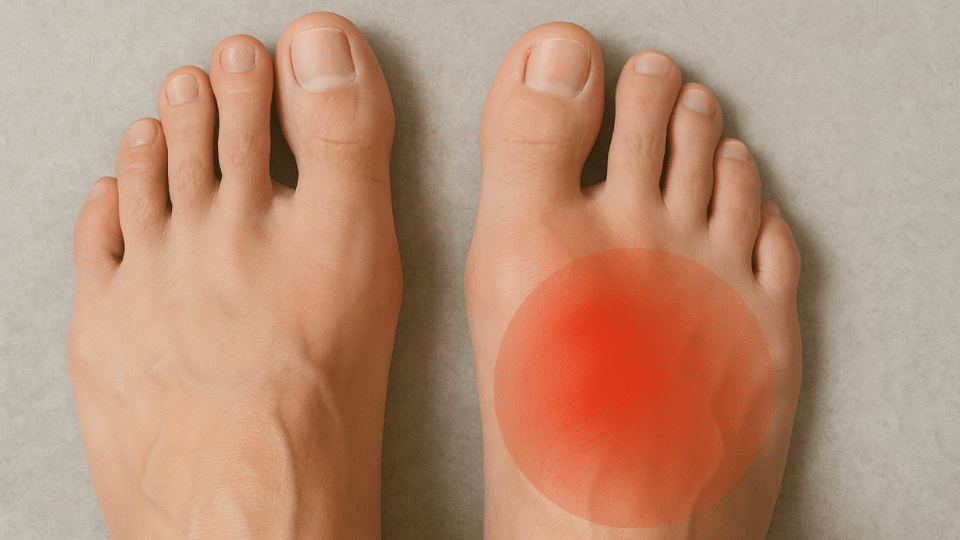Stabbing pain on top of foot can be a sharp, sudden sensation that interferes with daily activities. Whether it’s caused by an injury, overuse, or nerve irritation, this type of pain can be debilitating and prevent you from walking comfortably.
At Fall Creek Foot & Ankle, we specialize in diagnosing and treating foot pain. In this article, we’ll explain the common causes of stabbing pain on the top of the foot, along with effective remedies and prevention strategies to help you regain mobility and ease your discomfort.
Common Causes of Stabbing Pain on Top of the Foot
There are several reasons why you might experience stabbing pain on top of your foot. Below are the most common causes:
Nerve Irritation or Compression
One of the leading causes is nerve irritation or compression. This can occur when the nerves in the foot become pinched or compressed, causing sharp, shooting pain. Common conditions that cause nerve issues include:
- Tarsal Tunnel Syndrome: This condition occurs when the posterior tibial nerve is compressed as it passes through the tarsal tunnel near the ankle. This can cause stabbing pain, tingling, or numbness on the top of the foot.
- Morton’s Neuroma: A thickening of the tissue around a nerve, usually between the third and fourth toes, can cause pain that radiates to the top of the foot, especially during activity or pressure on the foot.
Foot Injuries and Trauma
Injuries or trauma to the foot, such as sprains, fractures, or contusions, can also result in stabbing pain on top of the foot. A foot fracture or sprained tendon may cause sharp pain, particularly when pressure is applied or while walking. Traumatic injuries such as stubbing your toe or dropping something heavy on your foot can lead to localized, sharp pain.
Plantar Fasciitis
Although plantar fasciitis typically causes heel pain, it can also affect the top of the foot, especially if there’s excessive strain on the foot’s arch. This condition involves inflammation of the plantar fascia, which can pull on the top of the foot and cause discomfort or a stabbing sensation.
Extensor Tendonitis
Tendons on the top of the foot, known as extensor tendons, allow the foot to lift the toes and move upwards. Overuse or injury can lead to extensor tendonitis, which causes inflammation and sharp pain along the top of the foot. This often occurs in athletes or people who frequently engage in high-impact activities like running or jumping.
Arthritis or Joint Inflammation
Arthritis, particularly in the joints of the toes or the midfoot, can result in stabbing pain on top of the foot. Inflammation in these joints can cause pain, stiffness, and limited mobility. The most common forms of arthritis affecting the feet are osteoarthritis and rheumatoid arthritis.
If you’re experiencing persistent or unexplained foot pain, it’s worth considering how it could be connected to your overall health. To learn more about the relationship between foot pain and your health, check out our blog on What Foot Pain Says About Your Health.

How to Stop Stabbing Pain on Top of the Foot: Effective Remedies
If you are experiencing stabbing pain on top of your foot, here are some effective treatments to help reduce the pain and speed up recovery:
Rest and Ice
Resting the foot and avoiding activities that aggravate the pain are essential in the early stages of recovery. Ice therapy can help reduce swelling and numb the area, providing temporary relief from stabbing pain. Apply ice for 15-20 minutes at a time, several times a day, to manage pain and inflammation.
Foot Elevation
Elevating the foot above the level of the heart can help reduce swelling, especially if you’ve experienced an injury. Keeping the foot raised allows gravity to assist in moving fluids away from the affected area, which can alleviate pain and reduce inflammation.
Supportive Footwear
Wearing shoes with proper arch support and cushioning is crucial for managing pain. Shoes that have a wide toe box and good heel cushioning can help reduce pressure on the foot, providing comfort while preventing further irritation. Avoid high heels or tight shoes that place excess pressure on the foot.
For expert advice on selecting the best shoes for your foot health, check out our Shoes, Shoes, Shoes guide.
Orthotics and Insoles
Custom orthotics or insoles are a great way to provide added support for the arch and reduce pressure on the tendons and nerves in the foot. If your foot pain is related to misalignment or flat feet, orthotics can help distribute pressure evenly across the foot, alleviating discomfort.
For more information on custom orthotics, check out our guide on Custom Orthotics: The Key to Foot Comfort and Mobility.
Physical Therapy
For persistent foot pain, physical therapy can help improve strength, flexibility, and overall foot function. A physical therapist can teach you specific exercises to manage foot pain and restore mobility, as well as guide you on proper walking and movement techniques to prevent future injuries.
When to See a Podiatrist for Stabbing Pain on Top of the Foot
If you’re experiencing persistent pain on top of foot that doesn’t improve with at-home care or if you notice swelling, bruising, or difficulty moving your foot, it’s time to consult a podiatrist. A foot specialist can evaluate your condition, determine the underlying cause of the pain, and recommend the most effective treatment plan.
For more information on when to seek professional care for foot pain, read our Foot Pain: When to See a Specialist blog.
Take the First Step Towards Foot Pain Relief
Stabbing pain on top of the foot can be a frustrating and debilitating condition, but with the right treatment and care, you can find relief. By understanding the causes of your foot pain and implementing effective remedies, you can alleviate discomfort, improve mobility, and get back to your daily activities with ease.
If you’re struggling with foot pain, don’t hesitate to reach out to Fall Creek Foot & Ankle. Our team of podiatrists specializes in treating foot pain, ensuring you receive the best care possible. Contact us today to schedule an appointment!
